|
October 3, 2006
Hello from Nova Scotia: A Commemoration
of Acadian History at Grand Pré National Historic Site
It’s always exciting to arrive in a new city. I like arriving
at night, so the suspense of this new place stretches into the next
morning. After a late arrival via Westjet at about 11:30 last night
at the Halifax Airport, I picked up my rental car at the Thrifty
Counter from a very friendly customer service representative on
duty who inquired whether he was going to be mentioned in my Nova
Scotia travel experiences – so here you go, this is a little
shout-out to the friendly young man working the late shift at Thrifty’s
who gave me my first welcome in Nova Scotia.
I then checked into the nearby Hilton Garden Inn for a brief, but
hopefully effective night of rest. Early this morning I got into
my rental car and on my way to my first destination: the Grand
Pré National Historic Site which commemorates the lifestyle
and expulsion of the Acadians, original French settlers that came
to this area in the 1600s. I first drove south from the airport
to locate Highway 101 and after several unsuccessful attempts to
find the right exit I finally linked up with the big highway that
connects Halifax with Nova Scotia’s western shore. The interior
of the peninsula is made up of gently rolling forested hills and
as you reach the northern shoreline, the land flattens out into
tidal mudflats. Windsor, Hantsport and Wolfville are the major local
settlements and the main body of water, the Minas Basin, features
the highest tides on earth.
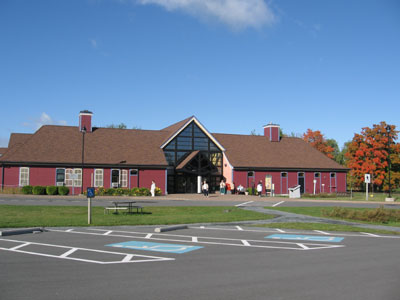
The Visitor and Interpretation Centre at the Grand Pré National
Historic Site
Less than an hour and a half after my departure I reached the Grand
Pré, French for “large meadow” where I met Victor
Tétrault, Executive Director of the Société
Promotion Grand-Pré, who filled me in on the history of this
site. The Grand Pré is an ancient settlement of the Acadians,
descendants of the original French settlers in north-eastern North
America. Acadians originally settled the areas around Nova Scotia,
New Brunswick and Prince Edward Island in the 1600s and are culturally
distinct from the French immigrants that settled in Quebec. The
earliest Acadian settlement took place in Port
Royal, less than two hours west of the Grand Pré, in
1604.
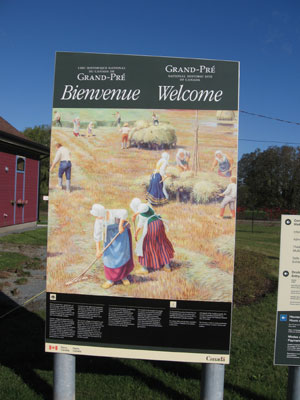
Acadians were astute farmers and through an ingenious system of
dykes they managed to reclaim large tracts of land from the ocean.
Victor explained that studies have shown that many farming communities
of this era were really based on subsistence farming, where the
average wealth base was “one unit of livestock” per
person . The Acadians were rather wealthy since their average wealth
per person was estimated at 8 to 9 units of livestock. They generated
more agricultural products than they needed for their own consumption
and started trading their surpluses with surrounding communities.
The Acadian settlers were also a peaceful group and got along well
with the local Mi’kmaq Indians, even learning their time-honoured
fishing and hunting techniques. The Mi’kmaq had developed
a fishing technique that involved a network of criss-crossed stakes
that would be set up in the tidal flats during low tide and when
the water levels rose, this mesh of wooden sticks would simply trap
fish and all that was necessary was just to go out there and pick
up the fish.
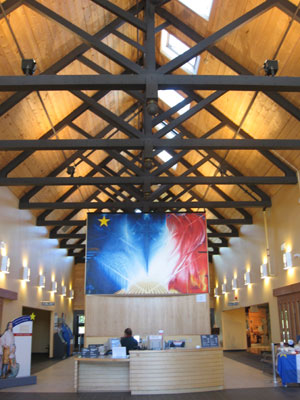
The reception area of the Visitor Centre
Territories in north-eastern North America changed hands numerous
times between the English and the French in the 1600 and 1700s and
the Acadians decided to remain neutral, refusing to take either
side. In the Treaty of Utrecht of 1713 France ceded Acadia as a
British procession, at which point the area became known as Nova
Scotia. During the following years, the British Governor Richard
Phillips tried to coerce the Acadians to swear an oath of allegiance
to the British Crown, but the Acadians steadfastly refused. Consequently,
the decision was made that the “French Neutrals” needed
to be removed and deported from their territories. Thus the Great
Expulsion, the “Grand Dérangement”, a brutal
act of ethnic cleansing, began.
Between 1755 and 1763 about 10,000 Acadians were rounded up and
deported to locations in New England, Maryland, Pennsylvania, Virginia,
North and South Carolina and Georgia, even as far awa as Martinique
and St. Domingue. Some Acadians were deported back to France, while
others tried to hide in the woods, often sheltered by their friends,
the Mi’kmaq. Some Acadian settlers made their way to relative
safety in Quebec. Many families were torn apart, their houses were
burnt, their livestock killed and fields destroyed. A great many
Acadian settlers ended up in the former French territory of Louisiana where the Acadians became known as the “Cajuns”. Some
families were expelled five or more times from different locations
they were deported to.
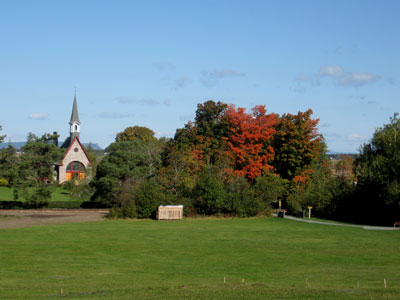
The Grand Pré National Historic Site, view towards the Memorial
Church
Although there were numerous deportations of different groups during
these turbulent historic times, the deportation of the Acadians
was unusual because so many were not sent back to France, their
country of origin, or another French colony. Instead they were deported
to British territories where Anti-Catholicism was rampant, and in
the southern colonies it was feared that the Acadians would join
slaves in a general uprising.
Once peace returned in 1763, some Acadians started to migrate back
but they never settled in their original settlement areas again.
Instead, many Nova Scotia Acadians moved into the area around Baie
Ste-Marie or St. Mary’s Bay between Digby and Yarmouth where
they took up fishing as a livelihood. Today hundreds of thousands
of people across all of North America and beyond can trace their
origins to the Acadian Diaspora.
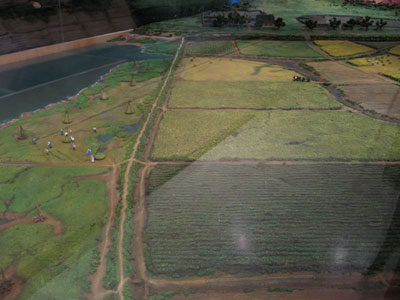
Display depicting the original Acadian settlement area
After giving me a brief introduction to Acadian history Victor
took me on a tour of the facilities. The Grand
Pré National Historic Site is actually a large piece
of land that was donated about 100 years ago by a local businessman
by the name of John Frederick Herbin who was an Acadian descendant.
He gave the land to the Dominion Atlantic Railway with the condition
that it be made accessible to Acadians forever. The company later
gave the site to Parks Canada which turned it into a National Historic
Site.
The New Visitors and Interpretation Centre houses a multimedia
theatre, an exhibit hall, a gift shop, a multipurpose room and administration
area along with other visitors' facilities such as restrooms, public
phones, etc. The entire facility is run jointly by Parks Canada
and the Société Promotion Grand Pré, which
represents the Acadian community. The grounds around the Centre
are made up of flat farmland, a winding river and railway tracks
that still serve for freight transportation.
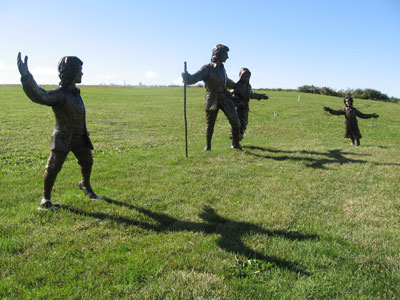
Bronze sculpture depicting deportation of Acadian family
We walked outside the Centre and Victor pointed out to me a metal
sculpture on the side of a long, low-lying hill that consists of
4 life-sized individuals, representing an Acadian family that is
being torn apart by the deportation. This sculpture was unveiled
just a few weeks ago, on September 3, 2006. Victor mentioned that
the sculptor was looking for an appropriate place to position the
sculpture once it had been transported to the Grand Pré site
from Montreal. The sculptor was unable to find a proper location
for his masterpiece, pacing for hours through the entire property.
Finally he found a spot, right there on the hillside. He just knew
that this was where the sculpture would have to go. Through archeological
research it had been discovered earlier, unbeknownst to the sculptor,
that an Acadian house had been located right next to the sculpture
and the foundation of this house is now outlined by wooden stakes.
Hearing about this psychic connection between Acadian history and
a present day sculptor gave me the goose bumps, and this example
just underscores the spiritual and historic significance of the
Grand Pré National Historic Site.
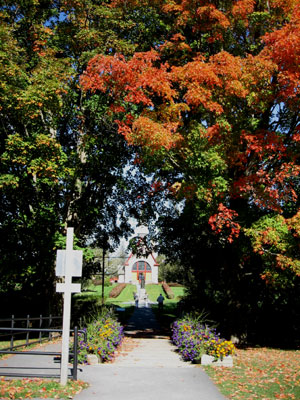
Fall colours at the Grand Pré National Historic Site
Victor also enlightened me that the Grand Pré is a location
of reconciliation. During the 2004 celebrations to commemorate the
400th anniversary of the arrival of the Acadians, tens of thousands
of Acadian descendants congregated in the Grand
Pré area for a reunion. The local Shaw family, a Planter
family who was assigned to settle the area after the expulsion of
the Acadians, invited the descendants of the Thibodeau family, who
had come from all over North America, to stay on their property.
Only two families had ever lived on this stretch of land: the Thibodeaus
and the Shaws. The Shaws as a matter of fact, had coined a phrase
“Be careful of the tippie-toes”, which really meant
“Be careful of the Thibodeaus”. Both groups of families
celebrated together and the Shaws stated that they were not the
owners, but rather the keepers of this land, and that their home
would always be open to the Thibodeaus.
The celebrations proceeded with exuberance until one man, a Thibodeau
family member from Quebec stated in front of everyone “I only
have one thing to say: we Thibodeaus are going to come back and
take this land”. The entire crowd gasped at the thought of
implied conflict until he continued “I am going to marry Sarah”.
Sarah was a member of the Shaw family. The audience breathed a collective
sigh of relief. This vignette is just one of many stories of reconciliation
and forgiveness that have taken place here in the Grand Pré
area.
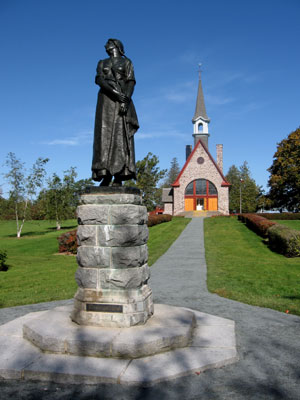
Statue of Evangeline with Memorial Church in background
Victor and I crossed the railway tracks and approached the Memorial
Church, built in 1922. In front of the church is a statue of Evangeline,
heroine of an 1847 poem by American author Henry Wadsworth Longfellow.
“Evangeline” tells the story of a young Acadian woman
who dedicates her entire life to searching for the man she loves
from whom she was separated at the time of deportation. The tragic
story concludes with Evangeline finding Gabriel, her true love,
on his death bed in Philadelphia.
Beside the church Victor pointed out some archeological excavations
to me. The Grand Pré site is a significant historic site
and ongoing archeological research has turned up more clues about
early Acadian life in the Grand Pré area. When Victor had
to say goodbye to me as he was on duty at the Memorial Church, I
went back inside the Visitors Centre and watched a brief yet extremely
informative video about the history of the Acadians which effectively
tied it all together for me.
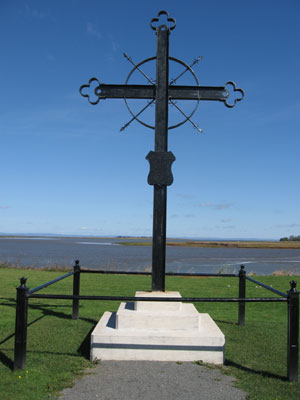
The Deportation Cross in the Minas Basin
After leaving the Visitor Centre I decided to drive a few kilometers
east to the actual deportation site in the Minas Basin. The Deportation
Cross was erected in 1924 to commemorate the deportation of 2000
Acadians who were deported from this very site.
As I started to make my way westwards towards Annapolis
Royal, another originally Acadian settlement, I reflected on
the significance of this site for one of the founding cultures of
Nova Scotia. I was amazed at the perseverance and the power of the
human spirit displayed by hundreds of thousands of Acadian descendants
who have lived in diaspora all over the world and for centuries
have managed to survive and hold on to their cultural heritage despite
much adversity that they have experienced. Despite all this human
tragedy and upheaval, the stories of reconciliation and forgiveness
found here at the Grand
Pré National Historic Site are a sign of hope for all
us.
Useful books about travel to Nova Scotia:
Related articles:
My five whirlwind days in Nova Scotia
Acadian
history at the Grand Pré National Historic Site
400 years of history at Annapolis
Royal
Port-Royal, a French habitation from 1605
Dinner at the Garrison House
in Annapolis Royal
The Annapolis Royal
Graveyard Tour
The Garrison House Bed and Breakfast
Exploring the Evangeline Trail from
Annapolis Royal to Yarmouth
Learning about Mi'kmaq heritage at the
Bear River First Nation Heritage and Cultural Center
Victorian heritage in Yarmouth
The MacKinnon-Cann Inn: Where Home
and Garden Television meets the Travel Channel
Yarmouth explained - the Yarmouth
County Museum
My car is in the ditch in Chebogue
River
The Lighthouse Trail from Yarmouth
to Shelburne
The Lighthouse Trail from Shelburne
to Lunenburg
The Town of Lunenburg - a UNESCO World Heritage
Site
An interview with the owners of the
Lunenburg Inn
The Lighthouse Trail from Lunenburg to
Halifax via Mahone Bay and Peggy's Cove
Arrival in Halifax and a stunning
musical performance - DRUM!
A Halifax city tour, the city's
connection to the Titantic and the 1917 Halifax Explosion
Exploring the Halifax Harbourwalk and
Pier 21 - Canada's immigration museum
A ferry trip to Dartmouth and saying
goodbye to Halifax
An interview with Pier 21 -
Canada's immigration museum
Helpful links for travel to Nova Scotia:
Tourism
Nova Scotia
Destination
South West Nova Scotia
Halifax Tourism
|